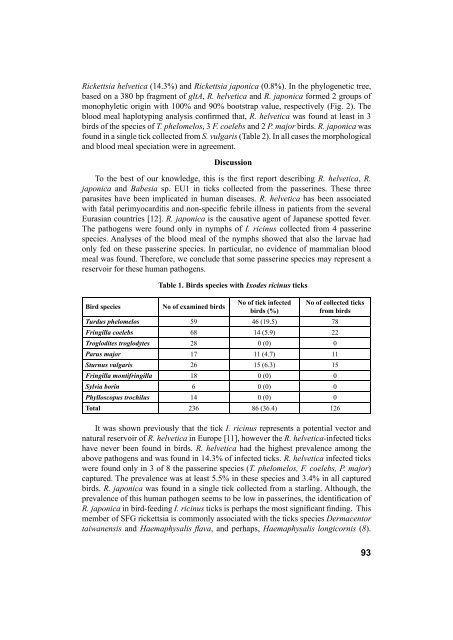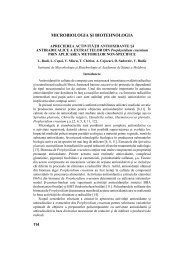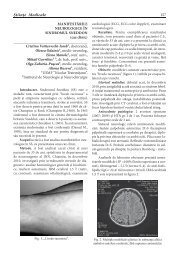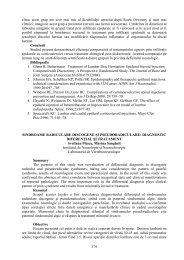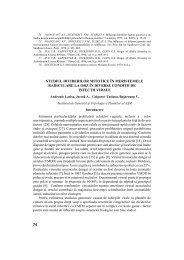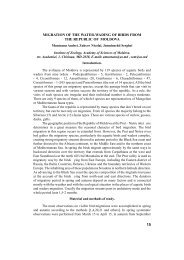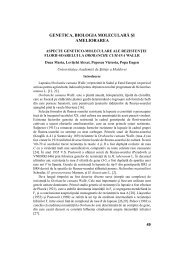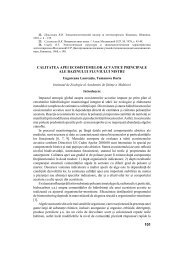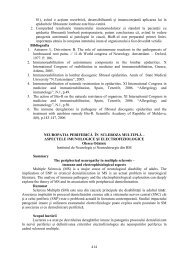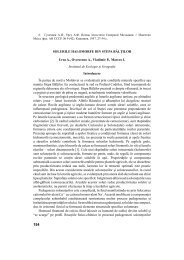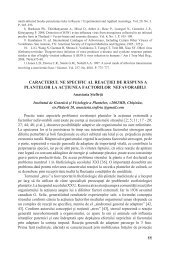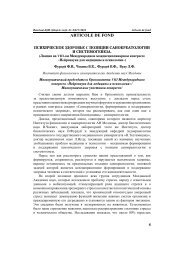198 CUPRINS
198 CUPRINS
198 CUPRINS
You also want an ePaper? Increase the reach of your titles
YUMPU automatically turns print PDFs into web optimized ePapers that Google loves.
Rickettsia helvetica (14.3%) and Rickettsia japonica (0.8%). In the phylogenetic tree,<br />
based on a 380 bp fragment of gltA, R. helvetica and R. japonica formed 2 groups of<br />
monophyletic origin with 100% and 90% bootstrap value, respectively (Fig. 2). The<br />
blood meal haplotyping analysis con rmed that, R. helvetica was found at least in 3<br />
birds of the species of T. phelomelos, 3 F. coelebs and 2 P. major birds. R. japonica was<br />
found in a single tick collected from S. vulgaris (Table 2). In all cases the morphological<br />
and blood meal speciation were in agreement.<br />
Discussion<br />
To the best of our knowledge, this is the rst report describing R. helvetica, R.<br />
japonica and Babesia sp. EU1 in ticks collected from the passerines. These three<br />
parasites have been implicated in human diseases. R. helvetica has been associated<br />
with fatal perimyocarditis and non-speci c febrile illness in patients from the several<br />
Eurasian countries [12]. R. japonica is the causative agent of Japanese spotted fever.<br />
The pathogens were found only in nymphs of I. ricinus collected from 4 passerine<br />
species. Analyses of the blood meal of the nymphs showed that also the larvae had<br />
only fed on these passerine species. In particular, no evidence of mammalian blood<br />
meal was found. Therefore, we conclude that some passerine species may represent a<br />
reservoir for these human pathogens.<br />
Bird species No of examined birds<br />
Table 1. Birds species with Ixodes ricinus ticks<br />
No of tick infected<br />
birds (%)<br />
No of collected ticks<br />
from birds<br />
Turdus phelomelos 59 46 (19.5) 78<br />
Fringilla coelebs 68 14 (5.9) 22<br />
Troglodites troglodytes 28 0 (0) 0<br />
Parus major 17 11 (4.7) 11<br />
Sturnus vulgaris 26 15 (6.3) 15<br />
Fringilla montifringilla 18 0 (0) 0<br />
Sylvia borin 6 0 (0) 0<br />
Phylloscopus trochilus 14 0 (0) 0<br />
Total 236 86 (36.4) 126<br />
It was shown previously that the tick I. ricinus represents a potential vector and<br />
natural reservoir of R. helvetica in Europe [11], however the R. helvetica-infected ticks<br />
have never been found in birds. R. helvetica had the highest prevalence among the<br />
above pathogens and was found in 14.3% of infected ticks. R. helvetica infected ticks<br />
were found only in 3 of 8 the passerine species (T. phelomelos, F. coelebs, P. major)<br />
captured. The prevalence was at least 5.5% in these species and 3.4% in all captured<br />
birds. R. japonica was found in a single tick collected from a starling. Although, the<br />
prevalence of this human pathogen seems to be low in passerines, the identi cation of<br />
R. japonica in bird-feeding I. ricinus ticks is perhaps the most signi cant nding. This<br />
member of SFG rickettsia is commonly associated with the ticks species Dermacentor<br />
taiwanensis and Haemaphysalis ava, and perhaps, Haemaphysalis longicornis (8).<br />
93


